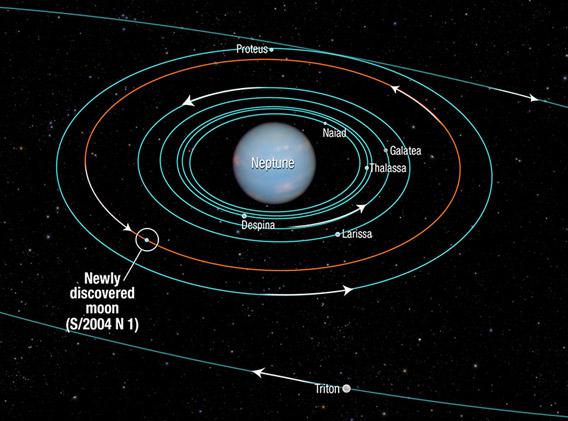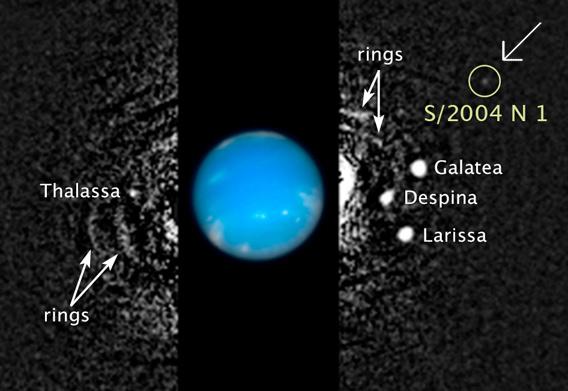Mark Showalter, an astronomer at the SETI Institute, was playing with some old Hubble images of Neptune and got a surprise: He found a moon!
I love this story. Neptune has ring fragments, arcs of material orbiting it that are essentially segments of rings. Showalter studies these arcs and went to the Hubble data archives to get a pile of old archived images of the planet taken by the space telescope, finding about 150 in all. He then used some techniques that allowed him to track the motion of the ring segments around Neptune. On a whim, he applied the technique to look for anything outside the ring system, and boom! There was a white dot that persisted in many of the images: Neptune’s 14th moon.

Illustration by NASA, ESA, and A. Feild (STScI)
The moon orbits Neptune at a distance of about 100,000 kilometers (65,000 miles) and is only about 20 kilometers (12 miles) across, which is pretty small. Also, since Neptune is over 4 billion kilometers (2.5 billion miles) from Earth, the moon is incredibly faint. That’s why it took so long to find, and it was almost by accident! Showalter’s method revealed the tiny iceball, and that’s the reason I love this story; he had the data, and he was really just playing around with it to see what he could see. I used to do that all the time with Hubble data, and once I found a dying star. It’s worth sometimes just indulging yourself; you never know what you might find.
The moon has a provisional name of S/2004 N 1 (which means it’s a planetary Satellite first seen in data from 2004, it’s orbiting Neptune, and the first one discovered in that year). It orbits the planet in about 23 hours, just under one Earth day.
Which gives me an idea for a potential name. Moons of Neptune are named for beings associated with the god of the oceans. There was no Roman god of tides per se, but the minor deity Volturnus was the god of waters, which is close (and not being used by any asteroid; always a problem when naming names). And tides on Earth have a period of just over a day, but hey, close enough to this new moon’s orbital period. So why not? Plus, Volturnus is a seriously kickass name.
It’s easy to forget just how far away Neptune is; it’s the gatekeeper of the outer solar system, and even with our fastest spaceships it takes many, many years to get out there. In some cases our best views are from telescopes right here on (or above) Earth. Hubble’s been orbiting our planet for more than 23 years now. What other treasures are buried in its data, just waiting to surface?
